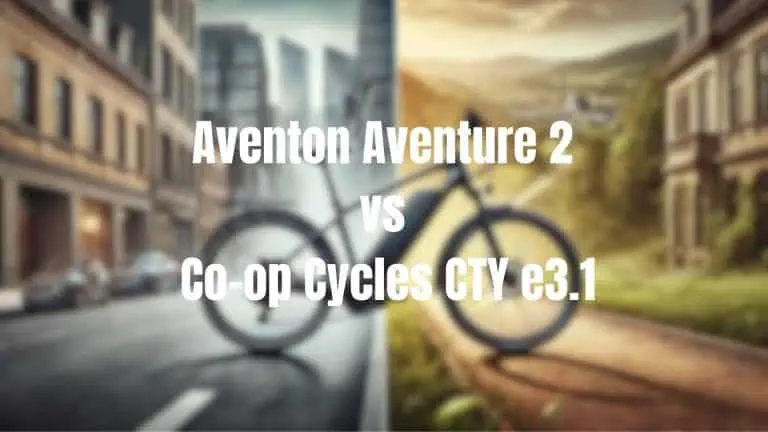Aventon Aventure 2 vs Co-Op CTY e2.1: A Comprehensive Comparison
In the diverse electric bike market, the Aventon Aventure 2 and the Co-Op CTY e2.1 represent two different approaches to e-bike design. While both aim to provide efficient electric-assisted transportation, they cater to different needs and preferences. Let’s compare these two models to help you determine which might be the better fit for your riding style.
Comparison Table
| Feature | Aventon Aventure 2 | Co-Op CTY e2.1 |
|---|---|---|
| Price | $1,799.00 | $1,799.00 |
| Motor Type | Rear hub motor | Rear hub motor |
| Power | 750W | 250W |
| Brakes | Hydraulic disc | Mechanical disc |
| Pedal Assist vs. Throttle | Pedal-assist | Pedal-assist |
| Weight | 77 lbs | 54 lbs. 8 oz. |
Price and Value
- Aventon Aventure 2: $1,799.00
- Co-Op CTY e2.1: $1,799.00
Interestingly, both bikes are priced exactly the same at $1,799.00. This price parity means that the decision between these two models will likely come down to their features and specifications rather than cost.
Motor Type and Power
- Aventon Aventure 2: Rear hub motor, 750W
- Co-Op CTY e2.1: Rear hub motor, 250W
Both bikes use rear hub motors, but there’s a significant difference in power output. The Aventon Aventure 2 boasts a 750W motor, which is three times more powerful than the 250W motor of the Co-Op CTY e2.1. This power difference could be noticeable, especially when climbing hills or accelerating from a stop.
Brakes
- Aventon Aventure 2: Hydraulic disc
- Co-Op CTY e2.1: Mechanical disc
The Aventon Aventure 2 features hydraulic disc brakes, which generally offer better stopping power and require less maintenance than mechanical disc brakes. The Co-Op CTY e2.1 uses mechanical disc brakes, which are still effective but may require more frequent adjustment and might not provide quite the same level of modulation as hydraulic systems.
Pedal Assist vs. Throttle
Both bikes use pedal-assist systems, meaning they provide power only when you’re pedaling. This creates a more natural riding experience and can help extend battery life compared to throttle-only systems.
Weight
- Aventon Aventure 2: 77 lbs
- Co-Op CTY e2.1: 54 lbs. 8 oz.
The Co-Op CTY e2.1 is significantly lighter than the Aventon Aventure 2, with a difference of about 22.5 pounds. This weight difference could be noticeable when handling the bike off-road, carrying it up stairs, or during longer rides.
Additional Considerations
- Intended Use: The Aventon Aventure 2, as its name suggests, is likely designed for more adventurous riding and potentially off-road use. The Co-Op CTY e2.1, with “CTY” in its name, is probably more focused on urban riding and commuting.
- Range and Battery: Due to its more powerful motor, the Aventon Aventure 2 may have a shorter range than the Co-Op CTY e2.1, although this would depend on the specific battery capacities and usage patterns.
- Carrying Capacity: The Aventon Aventure 2, with its more powerful motor and likely sturdier frame, may be better suited for carrying heavy loads or additional passengers.
- Brand and Support: Aventon has been making a name for itself in the e-bike market with quality products. Co-Op is REI’s house brand, which comes with the backing of REI’s customer service and their excellent return policy.
Which is Better?
The choice between these two e-bikes depends on your specific needs and preferences:
- Power: If you need more power for hills, off-road riding, or carrying capacity, the Aventon Aventure 2 has a significant advantage with its 750W motor.
- Weight: The Co-Op CTY e2.1 is notably lighter, which could be important if you need to carry the bike frequently or prefer a more nimble ride.
- Braking Performance: The Aventon Aventure 2 has an edge with its hydraulic disc brakes.
- Urban vs. Adventure Riding: For primarily city use and commuting, the Co-Op CTY e2.1 might be more suitable. For those planning to do some off-road riding or tackling more varied terrain, the Aventon Aventure 2 could be the better choice.
- Brand Preference: If you value the backing of REI’s customer service, the Co-Op CTY e2.1 might be more appealing.
In conclusion, the Aventon Aventure 2 is better suited for riders who prioritize power and don’t mind a heavier bike. It’s great for more adventurous riding, hilly terrain, or carrying groceries and gear.
The Co-Op CTY e2.1 might be preferable for those who want a lighter bike for urban commuting and don’t need as much power. It could be ideal for flat to moderately hilly terrain and riders who prefer a more traditional cycling experience with electric assistance.
Consider your daily riding needs, local terrain, and how much you value power versus weight when making your decision. Both bikes offer quality rides but cater to different priorities in the e-bike market.






